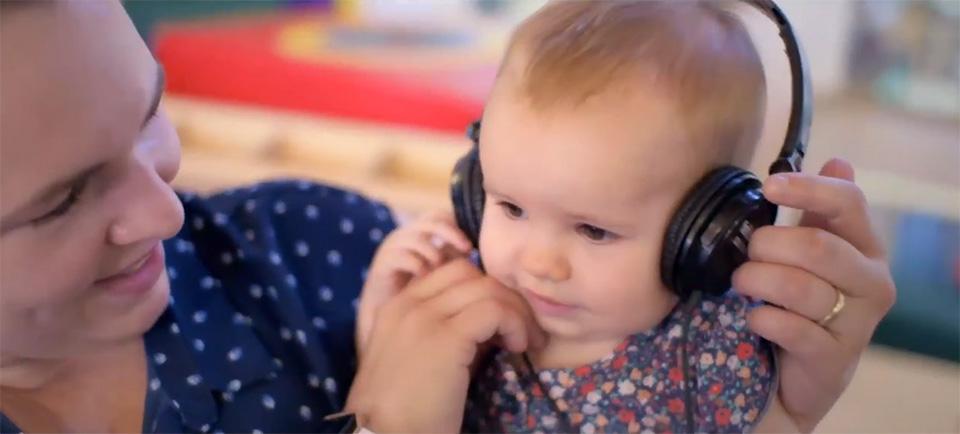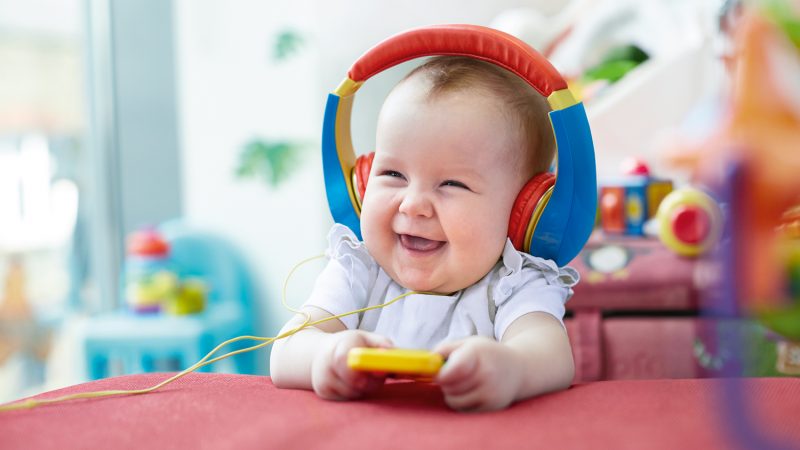Psychologists help design the first song scientifically tested to make babies happy
Thousands of British parents, two Goldsmiths psychologists, and a Grammy Award-winning musician, have helped C&G baby club create the first song to make babies happy, based on scientific research.

Almost 2,300 mums and dads across the UK were asked to name the noises that make their little ones cheerful so they could be added to ‘The Happy Song’, which is released today on Spotify and SoundCloud.
Top sounds include sneezing (51%), animal noises (23%) and baby laughter (28%), all of which are included in the song created by Dr Caspar Addyman and Professor Lauren Stewart (Department of Psychology), C&G baby club, musician Imogen Heap, advertising agency BETC London and music consultancy Felt Music.
The track, designed to encourage happiness and laughter in babies aged 6 – 24 months, was played to 56 infants, with their reactions monitored to see whether it worked.
Taking the sounds sent in by UK mums and dads, then working with previous research and hypotheses from Professor Stewart and Dr Addyman, singer-songwriter Imogen Heap began the process by producing four short tracks exploring different tempos, chord ranges and patterns, pitches, rhythms, performance cues and musical devices.
She tested them on her 18-month-old daughter, Scout, but more opinions were needed. So the Goldsmiths team carried out a three-month testing process at the university’s InfantLab, identifying the ingredients needed to create the ultimate happy song.
Supported by Felt Music, they monitored more than 50 babies’ reactions to the tracks, including movements, facial expressions, heart rate and vocalisations to see which parts of the song created a positive mood.
A clear composition emerged after three months. To ensure the song worked on as many babies as possible, Imogen and the psychologists took the track and gave it more happy tests.
Tempos and pitches were further raised and lowered and ‘plosive sounds (consonant sounds formed stopping airflow) were inserted – all musical elements the psychologists predicted would makes babies happy.
Then, after one last round of testing, the little smiles, giggles and dance moves showed that the sound of happy had been found.
The two-minute tune takes us on a bouncing melodic journey of cute lyrics and funny sounds – from the sky to the ocean, on a bike, submarine and even a rocket. 4/4 tempo was chosen as it is the most popular and easy to dance to. Imogen composed the song in the key of E flat as it was the key Scout sang a melody in on their first studio session.
Contributors also include a Pomeranian dog, Scout’s dad for some whistling, and Imogen’s mum for the chorus.

Developmental psychologist Dr Addyman led the baby testing. He said: “In the past, researchers have looked at how noises and music might sooth or distress babies. Rarely has anyone focused on what sounds make babies happy.
“Our unusual team of parents, babies, scientists and the talented Imogen Heap each brought unique elements to the project, resulting in this fun, uplifting track that makes babies smile.
“The final song is a clever mixture of appealing sounds, musical motifs and interactive lyrics that give babies and parents a refreshing modern alternative to nursery rhymes.”
Louise Morley, Brand Manager at C&G baby club (Cow & Gate’s pregnancy and baby advice network) commented: “This song has been designed for parents to use at home, in the car or out and about, in those moments when parents want to celebrate their little ones’ happiness. The song can be used to create a fun and rewarding bonding experience between baby and parent.”
BAFTA-winning director Michael J. Ferns from Pretzel Films directed the music video, which shows seven families enjoying the song.
Listeners can learn more about how the song was created with the three minute ‘Making The Happy Song’ film, which summarises the eight-month process from idea creation to final performance.
Professor Lauren Stewart is co-director of the Music, Mind and Brain research group at Goldsmiths and holds research expertise in the cognitive neuroscience of music, therapeutic uses of music, synaesthesia and musical imagery.
Lecturer in Psychology, Dr Caspar Addyman is a developmental psychologist specialising in learning in infancy. He is a member of the Department of Psychology’s InfantLab.
Watch ”The Happy Song” on youtube:
Watch ”The Happy Song – Making Of ” video with Caspar and Lauren on YouTube:
Visit www.soundofhappy.com for more information
by Sarah Cox, Via
